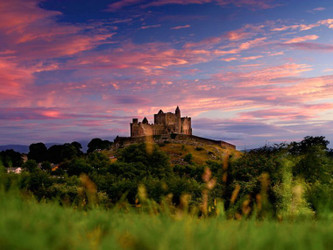The Top 7 Ancient Sites in County Tipperary
Posted by Adam Farley on 12th Mar 2019
County Tipperary is probably best known popularly through the World War I era song “It’s A Long Way to Tipperary” in which an Irishman forswears the grand sights of London and pines for his love back home in Ireland. But what the song doesn’t mention about Ireland’s largest landlocked county is that Tipperary is home to a number of its own stunning attractions, from medieval town walls and historic castles to ancient high crosses and a holy well associated with St. Patrick. So next time you’re in Ireland, make sure to include these seven County Tipperary landmarks on your itinerary.
FETHARD TOWN WALLS

(Mike Searle Via Wikimedia Commons)
To visit the southern Tipperary town of Fethard is to step back in time to Medieval Ireland. The town is still nearly completely surrounded by its 13th century fortified wall constructed at the orders of King Edward I following the Norman invasion of Ireland. Though only one of the wall’s five original gates still stands, about 90 percent of the 3,609 foot-long wall remains, making it the most complete medieval wall in Ireland. Inside, you’ll find even more remnants of the past, including the 13th century Holy Trinity Church, one of the best preserved and largest examples of a parish church from the time.
CAHIR CASTLE

(Kevin Lawver via Wikimedia Commons)
Built in 1142 and continually expanded until 1599, Cahir Castle is a near-perfect example of medieval Irish defensive construction. Built on an island in the River Suir, the complex is also one of Ireland’s largest castles, perhaps explaining why it was the site of attack and siege for centuries before succumbing to disrepair in the 18th century. Ownership of the castle was turned over to the Irish state in the 1960s after the last Lord of Cahir died and it is now one of the county’s top tourist attractions. Inside, you’ll find an impressive audio-visual program in several languages that explains the history and significance of the castle in great detail.
AHENNY HIGH CROSSES

(Wikimedia Commons)
This pair of 8th century Irish high crosses is part of Ossory group of high crosses, the oldest collection of ringed Celtic crosses anywhere in the country. Located on the grounds of the ruins of the Kilclispeen monastery, the two crosses at Ahenny — known simply as the north and south crosses — are among the most richly detailed and best preserved examples of this early Irish Christian art form. Both crosses stand over 9 feet tall and are carved with intricate Celtic knot work meant to resemble the older wooden crossed on which these are based. The foundations of each cross also feature detailed carvings, with the north cross depicting an image of David bringing Goliath to Jerusalem and the south cross showing an Irish chariot.
ST. PATRICK’S WELL

(Flickr)
Just outside the town of Clonmel is one of the largest ancient holy wells in Ireland. Legend has it that St. Patrick was working his way south through Ireland to complete his conversion of pagan Ireland to Christianity when he was confronted by St. Declan, who had already been at work in the area. The two allegedly had a disagreement over the best way to go about preaching to the regional kingdom of Déisi Muman, of which Declan was a member and Patrick an outsider. But instead of coming to blows, the two decided to work together and Patrick was granted the natural spring that would become St. Patrick’s Well as a show of good faith. Today, a small 5th century cross stands on a small island in an artificial pool built to collect the wellspring runoff while around the pool lies tranquil landscaping and a 17th century church.
KILLENURE CASTLE

(Flickr)
Killenure Castle, located outside the small town of Dundrum, is undoubtedly one of the most unique houses in Ireland today. Representing over 450 years of architectural history, no one period defines its construction. Most recently, it was purchased by husband and wife team Eavaun Carmody and Emmet Sexton and restored in 2007. The couple now live there with their three children and a small herd of Dexter cattle. Kept in a state of arrested decay, the castle can be visited by appointment during the summer months.
ORMOND CASTLE

(Tripadvisor)
Built by the Earl of Ormond in the 1560s, Ormond Castle is an utterly singular Elizabethan manor house. It is the only major house of its kind from the period that is unfortified, though two 15th century towers are incorporated into the house. One possible reason the house is unfortified is that the Earl of Ormond was Queen Elizabeth’s cousin, through Anne Boleyn, meaning any attach on the castle would be an attack on the royal family. Restored in the 20th century, one of the castle’s most impressive rooms is the first floor gallery, which features a plasterwork sculpture of Queen Elizabeth flanked by images of Equality and Justice.
ROCK OF CASHEL

(Heritage Ireland)
Once the seat of the King of Muenster and believed to be the location of St. Patrick’s conversion of the king to Christianity, the Rock of Cashel is one of the most visited tourist sites in Ireland. the name of a single building itself, the Rock of Cashel actually refers to the limestone outcrop atop which sits a grand collection of medieval Irish structures, including a 12th century round tower, high cross, Romanesque chapel, 13th century Gothic cathedral, 15th century castle and the Hall of the Vicars. It is universally recognized as one of the premier collections of Celtic art and medieval architecture found anywhere in Europe.
******
Did we leave your favorite Tipperary site off our list? Let us know in the comments below!

